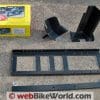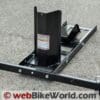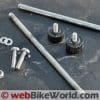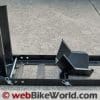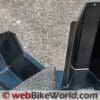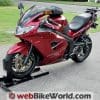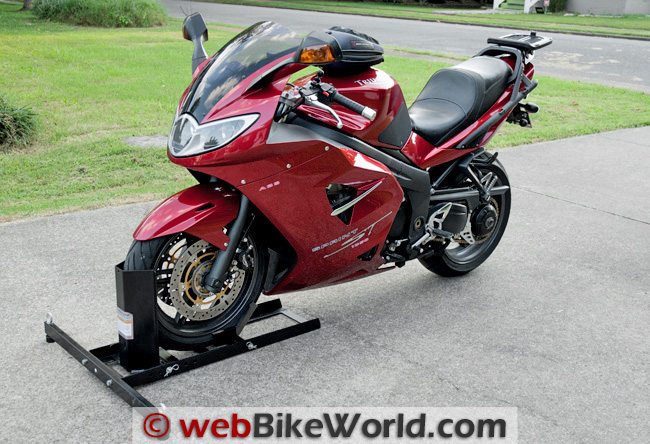The U.S. General Motorcycle Stand is a simple and sturdy stand and wheel chock that lacks refinement and some adjustability.
Some steps may need to be taken to secure it if used in free-standing mode.
It is convertible from a wheel stand to a motorcycle front wheel chock.
A couple of years ago, I asked our Editor here at webBikeWorld if he wanted a review of a Harbor Freight wheel chock I had just purchased.
The chock in question at that time was not the one reviewed here today, but instead was a lighter weight unit that I found to perform so poorly I decided to return it a few days later.
Needless to say. I didn’t even take the time to review the thing.
A few weeks later though, I had a second bike to put in the garage and felt the best way to maximize the space would be to have both bikes on wheel chock type stands because storing the bikes upright would take up less room.
As is typical for me, I was on a budget, so I turned once more to Harbor Freight, but not at the same unit I had previously purchased.
This time I decided to try the U.S. General Motorcycle Stand Wheel Chock, hoping that it would prove a bit more robust than the previous purchase.
I was still spending a lot less money than most “quality” wheel chocks so I had my concerns.
I remember thinking as I struggled out the door of the shop with the 40-pound package that if it’s half as good as it is heavy, it could be a contender!
So how did it turn out? Let’s have a look.
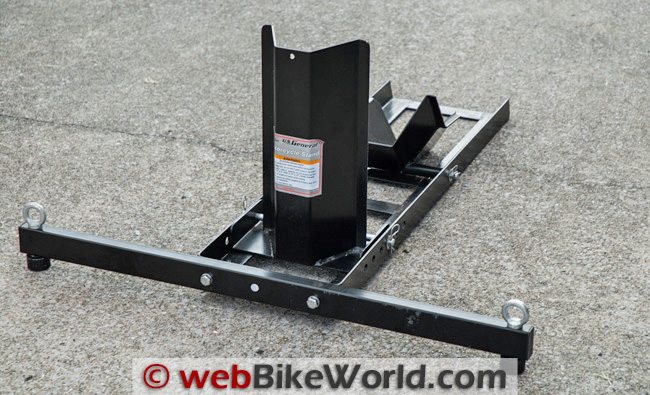
The U.S. General Motorcycle Stand – Wheel Chock
Heavy. If I had to use one word to describe the U.S. General Motorcycle Stand Wheel Chock it would be “heavy”.
However, in this case, weight isn’t necessarily bad. It’s heavy for a reason and that reason is the 12-gauge steel plate that makes up the majority of the construction of this front wheel chock.
It may not be pretty, but it certainly should be tough.
The U.S. General Motorcycle Stand Wheel Chock is designed to be used as either as a front stand in its free-standing mode, or it can be bolted to a trailer floor or truck bed when used as a wheel chock.
In its free-standing configuration, there is a cross bar at the front of the chock that provides lateral stability and keeps the unit from tipping over when the motorcycle is pushed on to the stand and parked in it.
At the ends of the crossbar there are two large metal eyelets on top which can be used to connect straps to the front of the motorcycle and secure it to the stand.
According to the documentation, the stand is capable of supporting 1,800 lbs. and it accommodates three- to five-inch wide wheels, including wheel diameters from fifteen to twenty-two inches.
And about that weight…the Harbor Freight U.S. General Motorcycle Stand Wheel Chock tips the scales at just over 37 lbs., which does put it at the back of the line of choices for a “portable” motorcycle wheel chock or front stand solution.
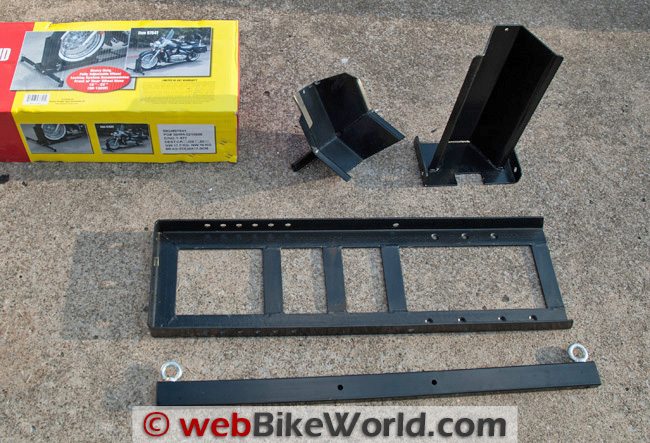
Construction and Assembly
The U.S. General Motorcycle Stand Wheel Chock is very simple in design. There are only three main components to the wheel chock, and to convert the chock into a stand one only has to attach the crossbar.
The main components consist of the base, the pivoting tire cup, and the front stay.
Each of these components are made from the 12-gauge steel plate and are powder coated in black. In addition to the main pieces there are only a handful of smaller parts that go into assembling this wheel chock.
A pair of lock nuts and bolts to attach the crossbar and plastic feet that go at the lower ends of the crossbar.
The only other pieces are two metal rods and four cotter pins that hold the front stay and tire cup in place.
“Form follows function” is what comes to mind when looking at this chock and there is very little mystery as to how the parts all fit together.
In my case, I only gave the included instructions a cursory glance before beginning assembly as the photo on the box really does provide all the insight needed into putting together the stand.
Even if you take your time, the wheel chock can be assembled in less than a minute (minus the crossbar). To do this, just take the tire cup pivot, set it in the desired spot in the base, and then slide one of the metal rods through. The same is done for the front stay.
Once in the correct position, cotter pins are used to keep the rods in place.
Adding the crossbar into the mix still only adds a few minutes at most to the assembly time. This entails bolting the bar to the front of the wheel chock base and then attaching the metal eyes and plastic feet.
Overall it can take more time to brush all the little bits of Styrofoam from the packaging off the stand than it will to assemble it!
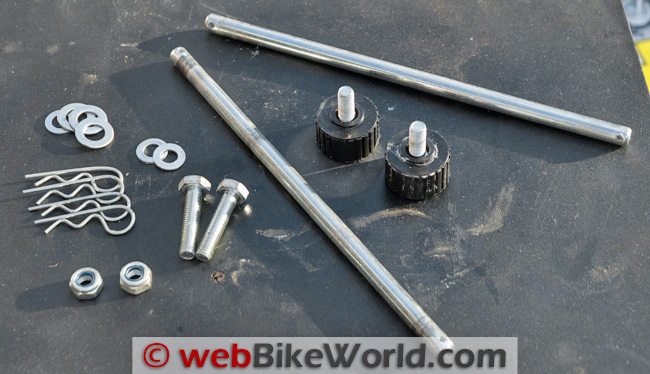
Using the U.S. General Motorcycle Stand and Wheel Chock
Once it’s assembled, it’s not exactly a work of art, but it is functional. As the bike is rolled up onto the wheel cup and the tire slips into the front stay, there can be some clanging noise.
The metal rods aren’t a snug fit in their components so there is plenty of play in the fit.
Also, it can sound like one just dropped a small iron skillet on the floor when rolling in or removing a bike from the chock, but this doesn’t detract from the functionality.
I have been parking my Suzuki SV650s in this wheel chock for over two years in my garage and have had zero problems with the bike staying put.
For the first couple of weeks I would put the side stand out and make sure the bike was leaning ever so slightly to the left just case the chock failed, but it never did. Again though, this was with my SV650 with a 120 width front tire.
If you have a bike with a front tire that is narrower than 110, the stand may not work as well.
At one point, I tried parking our NX250 in this wheel chock as well (I had two of these chocks at the time).
The narrow front tire of the NX250 (a 90 mm width if I recall correctly) wasn’t wide enough to get any purchase in the front stay of the chock.
Trying to park our 1978 Suzuki GS550E in the stand didn’t work out well either.
The bike’s narrow 100 mm width tire seemed to stay in place but the next morning I found the bike leaning on the SV next to it for support.
Our Honda CB-1 with its 110-series front tire, however, seemed to be stable and was not a problem over the months we parked it in the chock.
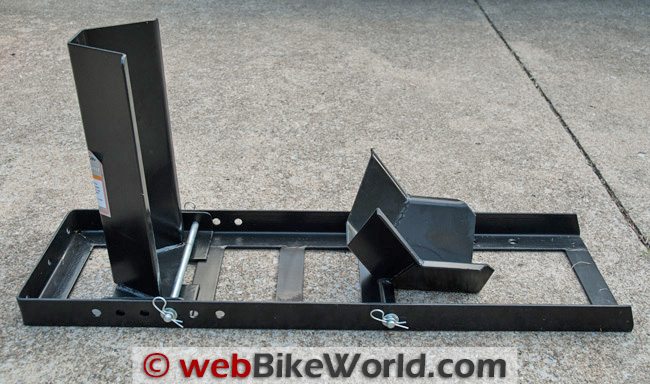
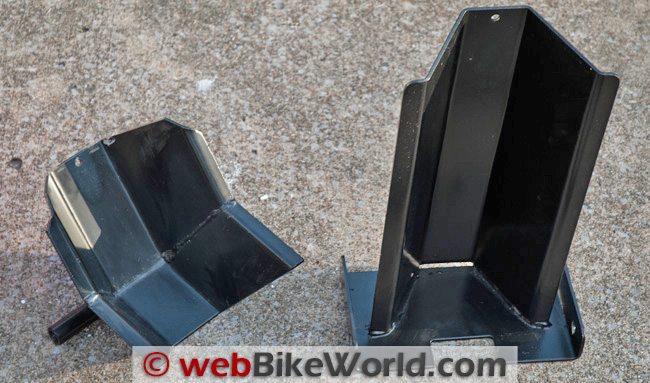
Tips and Tricks
Even though the unit is quite heavy as mentioned earlier, unless extra steps are taken, the wheel chock may not stay in place when putting the bike in or removing it from the stand.
The plastic feet on the cross bar do not have much grip and the entire chock tends to slide away from the front wheel as one tries to get the tire in and over the pivot point of the wheel cup.
I have read that some owners of these wheel chocks put down a small piece of carpet underneath the feet to help it stay in place. In my own usage, I have the chock backed up against shelving in the back of my garage so it cannot slide back.
Removing the bike from the chock can also case some issues with the base of the stand failing to gain a good purchase on the ground underneath it.
In my case, I find it easy enough to put my foot down against the base of the wheel chock to keep it in place as I pull back on the bike to remove it from the chock.
I also have noticed that with heavier bikes, such as the Triumph Sprint pictured, the front tire will tend to wedge itself into the chock. This makes an already heavier bike even harder to pull out of the chock.
Conclusion
The U.S. General Motorcycle Stand Wheel Chock is a sturdy and reliable way to park some motorcycles.
Since the chock is not adjustable for tire width, some bikes with narrower tires may not want to remain secured in place.
What the wheel chock lacks in elegance and refinement, it makes up for with simplicity and price.
There are certainly wheel chocks out there that have more features, and many have been reviewed here on webBikeWorld, but none come in under $100.00 like this one which lists for $89.95 and is usually found on sale for less than that.
More webBikeWorld:
| wBW Review: U.S. General Motorcycle Front Wheel Stand | |
|---|---|
| Manufacturer: “U.S. General” | List Price: $89.95 + S/H |
| Colors: Black | Made In: China |
| Review Date: September 2012 | |
Owner Comments and Feedback
See details on submitting comments.
From “D.R.” (October 2012): “This stand definitely makes a case for “you get what you pay for”.
Yes, it is very inexpensive. Yes, the product reeks of typical “made in China” build quality. Yes, there are much better alternatives out there (albeit much more expensive too).
But does it work? Surprisingly, yes.
I’ve used my USG stand to hold an SV1000S, R1 and RC51 (all with 120 fronts) with zero failures or tip-over accidents.
The design is so simple I can’t imagine a mechanical failure. I’ve used my stand for 5 years now and so far I’ve not seen or noticed any material failure either.
The biggest cons to me are getting the bike out of the stand and the weight.
In my garage, I use some strategically placed non slip cabinet matting to help hold the stand in place; sometimes putting my foot on the stand as I yank the bike out works better.
Before getting a trailer, I used to take my SV to the track in the back of a (Toyota) Tacoma with this stand in the bed. After driving home at the end of the day, the hot tire would cool and attach itself to the stand pretty effectively.
It would take a ridiculous amount of effort to get the bike out of the stand, especially since the stand wasn’t permanently mounted to the truck.
Putting a rag between the tire and upward V-shaped stop solved the problem, but it’s something to consider.
The other negative is the weight of the stand. At close to 40 lbs, it’s no fly-weight and you have to be careful moving it around the garage or in and out of a truck bed to avoid nicking anything expensive.
With those negatives aside, this stand is a welcome addition.
Motorcycles are money pits and anytime a product comes along that can do what other more expensive models do for one-quarter of the cost is a positive to me.
A Baxley or Condor would be nicer and maybe a little easier, but I’ll save that money for gas and tires instead.”
From “B.C.M.” (October 2012): “I had occasion to trailer three bikes from the Midwest to the Pacific Northwest this summer. My reactions to this stand are mixed.
If price is the sole determining factor in any purchase you make, this is probably the stand for you. In fact, I see that the stand is probably satisfactory for use as a shop stand or for hauling a single bike on a trailer.
However, be forewarned that this stand takes up a huge amount of real estate on the floor of a trailer.
To the point where we had a very difficult time positioning three bikes in a 7 x 14 ft. trailer (usually not a problem). I had two Baxley Sport Chocks (review) along on that same journey and they worked splendidly for the entire 4000 miles.
The USG stand (that a friend assembled and brought along with his bike) actually came apart at one point in the trip! The chock also kept moving on the floor requiring repeated retightening of bike restraints.
Ultimately, the bike fell twice. I can’t in good conscience recommend this chock. The Baxley chocks (LA or Sport) are both quite superior and take up much less floor space in a trailer — but of course cost more.”
From “J.M.” (September 2012): “I have 2 of these and paid about $45.00 each with a coupon. A co-worker who owns a welding company has told me he couldn’t afford to make it at that price, even if he used scrap.
I have a Chevy Colorado and keep one mounted in the bed 24/7 using steel D-rings to attach it to the bed tie downs vie the tie down bolts on the stand. The other is mounted on a trailer I have.
I’ve used the truck mounted one to transport bikes from New York to Texas and California and back on 4 different occasions along with picking up broken down friends, transporting bikes I’ve bought and sold, etc.
Everything from a Victory Kingpin to a KLR650, Transalp, CB1000, GS500, Kawasaki Zephyrs (1100 and 750) have all been moved in that truck bed with the same stand over a 3+ year period.
I’m all for Buy American but this is a value that is unbeatable. The bikes will stand on their own as soon as you place them in the stand and this allows for easy tie down in tall/removal.
Bikes like the KLR and Transalp with a 21″ front wheel and high center of gravity can be a little less stable until tied down, but every road bike I’ve used it with is a piece of cake. Cake is good!”



